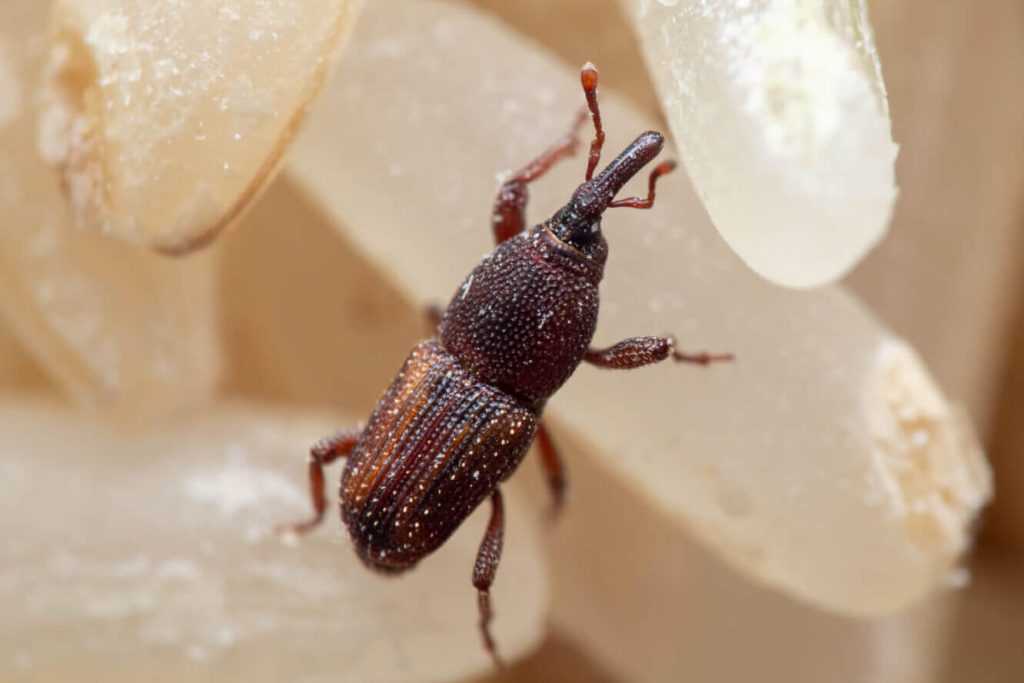Rice, the staple food for over half of the world’s population, is not immune to infestations. Among the most common pests that plague stored rice is the rice weevil (Sitophilus oryzae), a tiny but formidable adversary.
These pesky insects can cause substantial damage to rice stocks, leading to significant financial losses and food wastage. In this comprehensive guide, we will explore the biology of rice weevils, identify signs of infestation, understand the reasons behind their prevalence, and most importantly, learn effective methods to get rid of them while ensuring the preservation of your precious grains.
Understanding the Rice Weevil
The rice weevil is a reddish-brown beetle with a distinctive elongated snout. It is about 2-3 mm in size, making it difficult to spot with the naked eye. Both adult weevils and their larvae can cause damage to stored rice.
The adult female deposits eggs inside the grains, where they hatch into small, white larvae that feed on the rice’s interior, causing further destruction.

Signs of Rice Weevil Infestation
Identifying a rice weevil infestation early is crucial for preventing the spread of these voracious pests. Some common signs include:
- Presence of live adults: If you spot tiny reddish-brown beetles in your rice container, it’s a clear indication of an infestation.
- Larvae and pupae: Look for tiny white worms or cocoon-like structures in the rice, signaling an advanced infestation.
- Webbing and dust: Rice weevils produce webbing and leave behind a powdery dust known as frass as they burrow inside the grains.
- Off-odor: A musty or rancid smell emanating from the rice might indicate a rice weevil infestation.
Causes of Rice Weevil Infestation
Understanding the factors that contribute to rice weevil infestations can help prevent them in the future:
- Poor storage practices: Leaving rice exposed to air and humidity can create an ideal environment for weevil breeding and infestation.
- Contaminated grains: Rice weevils can hitch a ride into your home through contaminated grains from the store.
- Temperature and humidity: Warm and humid conditions promote weevil activity and breeding, accelerating their life cycle.
- Lack of cleanliness: Failing to clean storage containers and surrounding areas regularly can attract pests.
Read also: How to get rid of spider mites on roses
How to get rid of rice weevils
- Freezing
- Heating
- Diatomaceous earth (DE)
- Bay leaves
- Vacuuming
- Store in airtight containers
- Regular cleaning
- Monitor nearby food sources
- Use traps
- Professional fumigation
- Freezing: If you suspect your rice has been infested, placing it in the freezer for at least a week will kill all life stages of rice weevils, including eggs, larvae, and adults. Ensure the rice is in an airtight container to prevent moisture absorption.
- Heating: Similarly, heat can be used to kill rice weevils. Pop the rice in the oven at a temperature of around 140°F (60°C) for 1-2 hours. Again, store the rice in a sealed container after treatment.
- Diatomaceous Earth (DE): DE is a natural, non-toxic insecticide made from fossilized algae. It is safe for humans and animals but deadly for pests like rice weevils. Sprinkle a thin layer of DE around your rice storage area and mix some into the rice to protect against future infestations.
- Bay leaves: Bay leaves act as a natural repellent for rice weevils. Place a few dried bay leaves in your rice container to keep the bugs at bay.
- Vacuuming: If you notice signs of an infestation, use a handheld vacuum to suck up the weevils and larvae. Dispose of the vacuum bag immediately to prevent reinfestation.
- Store in airtight containers: Transfer your rice to sturdy, airtight containers as soon as you bring it home from the store. This prevents weevils from gaining access to the grains.
- Regular cleaning: Clean your rice storage area regularly, removing any spilled grains and ensuring no food debris remains.
- Monitor nearby food sources: Rice weevils are not picky eaters and can feed on various grains and cereals. Keep a vigilant eye on nearby food sources to prevent weevils from spreading.
- Use traps: Commercial traps specifically designed for rice weevils are available. These traps contain pheromones that attract weevils, leading them to their demise.
- Professional fumigation: In severe infestations, professional fumigation may be necessary. This should only be carried out by trained professionals and as a last resort.
Read also: How to get rid of bean weevilsPreventing Future Infestations
While it’s essential to know how to get rid of rice weevils, prevention is always better than cure. Here are some preventive measures:
- Regularly inspect stored rice for signs of infestation.
- Before purchasing rice, check for signs of weevils in the packaging.
- Store rice in a cool, dry place to discourage weevil breeding.
- Consider using food-grade diatomaceous earth as a preventive measure.
- Rotate your rice supply regularly, using older stock first.
The bottom line
Rice weevils can be a formidable adversary for anyone dealing with stored rice. Understanding their behavior and employing effective control measures is vital to safeguarding your precious grains.
Whether it’s freezing, heating, using natural repellents, or maintaining good storage practices, taking proactive steps can save you from potential infestations and ensure your rice remains safe and healthy for consumption.
By following the guidelines outlined in this article, you can take control of the battle against rice weevils and preserve the integrity of your rice supply.
Read also: How to grow tomatoes from plants